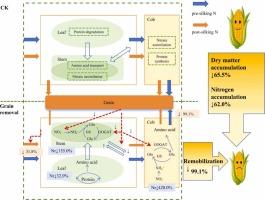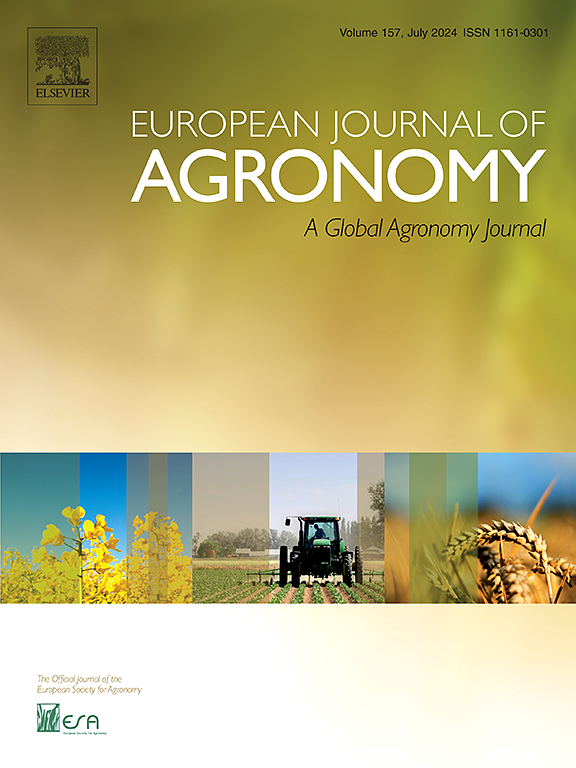Physiological mechanisms underlying nitrogen remobilization in the vegetative organs of maize in response to sink strength
IF 5.5
1区 农林科学
Q1 AGRONOMY
引用次数: 0
Abstract
While N remobilization is well-studied, the mechanisms by which grain sink strength feeds back on presilking-accumulated N remobilization, storage, and assimilation remain less well understood. This study aimed to determine how grain sink strength influences the presilking-accumulated N remobilization and the regulation of amino acid transport and nitrate assimilation, by examining two sink strength treatments (normal pollination, 3/4 grain removal), using two high-yield maize hybrids (ZD958 and XY335), over 3 years. Presilking-accumulated N remobilization dynamics in vegetative organs and grain N accumulation were assessed using 15N field-tracer labeling, along with measurements of N components and enzyme activities. The use of a 15N double-labeling assay revealed that reduced sink strength greatly decreased presilking-accumulated N remobilization in the leaves, stem, husk, cob and roots. Sink strength did not regulate protein decomposition in the leaves, stem, or leaf sheath but mainly regulated the import and export of amino acids (which come from the leaves) in the stem post-silking. When the sink strength is full, excess N in the form of amino acids is stored in the stem, and some amino acids synthesize proteins in the cob for cob growth. Nitrates absorbed post-silking might be assimilated, mainly in the stem and cob, regulated by the GS/GOGAT pathway. The negative feedback by reducing sink strength regulates the GS/GOGAT activity in the stem and cob, which weakens nitrate assimilation, resulting in nitrate accumulation. These findings suggest that sink strength does not directly regulate N decomposition in vegetative organs but only regulates the import and export balance of N in the buffer sinks (stem and cob). However, sink strength can directly regulate the GS/GOGAT-mediated nitrate assimilation process in stem and cob, which affects the total amino acid capacity of the buffer sink and might provide feedback on postsilking N uptake.

玉米营养器官对库强度响应的氮再动员生理机制
虽然氮素再动员已经得到了很好的研究,但籽粒汇强度反馈于吐丝前积累的氮素再动员、储存和同化的机制仍不太清楚。本研究以ZD958和XY335两种高产玉米杂交种为研究材料,通过3年的试验,研究籽粒库强度对采前积累氮再动员、氨基酸转运和硝酸盐同化的影响。采用15N田间示踪标记法,结合氮素组分和酶活性测定,评价了播前营养器官氮素再动员动态和籽粒氮素积累。15N双标记试验表明,汇强度的降低大大降低了采前叶片、茎、壳、穗轴和根中积累的N的再动员。下沉强度不调节叶片、茎和叶鞘中蛋白质的分解,而主要调节茎吐丝后氨基酸(来自叶片)的输入和输出。当库强度充足时,多余的氮以氨基酸的形式储存在茎中,一些氨基酸在穗轴中合成蛋白质,供穗轴生长使用。吐丝后吸收的硝酸盐主要通过GS/GOGAT途径在茎和穗轴上被同化。通过降低汇强度的负反馈调节茎和穗轴中GS/GOGAT活性,使硝酸盐同化减弱,导致硝酸盐积累。综上所述,库强度并不直接调节营养器官中氮的分解,而只调节缓冲库(茎、穗轴)中氮的进出口平衡。然而,汇强度可以直接调节GS/ gogat介导的茎和穗轴硝酸盐同化过程,影响缓冲汇的总氨基酸容量,并可能对丝后氮吸收提供反馈。
本文章由计算机程序翻译,如有差异,请以英文原文为准。
求助全文
约1分钟内获得全文
求助全文
来源期刊

European Journal of Agronomy
农林科学-农艺学
CiteScore
8.30
自引率
7.70%
发文量
187
审稿时长
4.5 months
期刊介绍:
The European Journal of Agronomy, the official journal of the European Society for Agronomy, publishes original research papers reporting experimental and theoretical contributions to field-based agronomy and crop science. The journal will consider research at the field level for agricultural, horticultural and tree crops, that uses comprehensive and explanatory approaches. The EJA covers the following topics:
crop physiology
crop production and management including irrigation, fertilization and soil management
agroclimatology and modelling
plant-soil relationships
crop quality and post-harvest physiology
farming and cropping systems
agroecosystems and the environment
crop-weed interactions and management
organic farming
horticultural crops
papers from the European Society for Agronomy bi-annual meetings
In determining the suitability of submitted articles for publication, particular scrutiny is placed on the degree of novelty and significance of the research and the extent to which it adds to existing knowledge in agronomy.
 求助内容:
求助内容: 应助结果提醒方式:
应助结果提醒方式:


